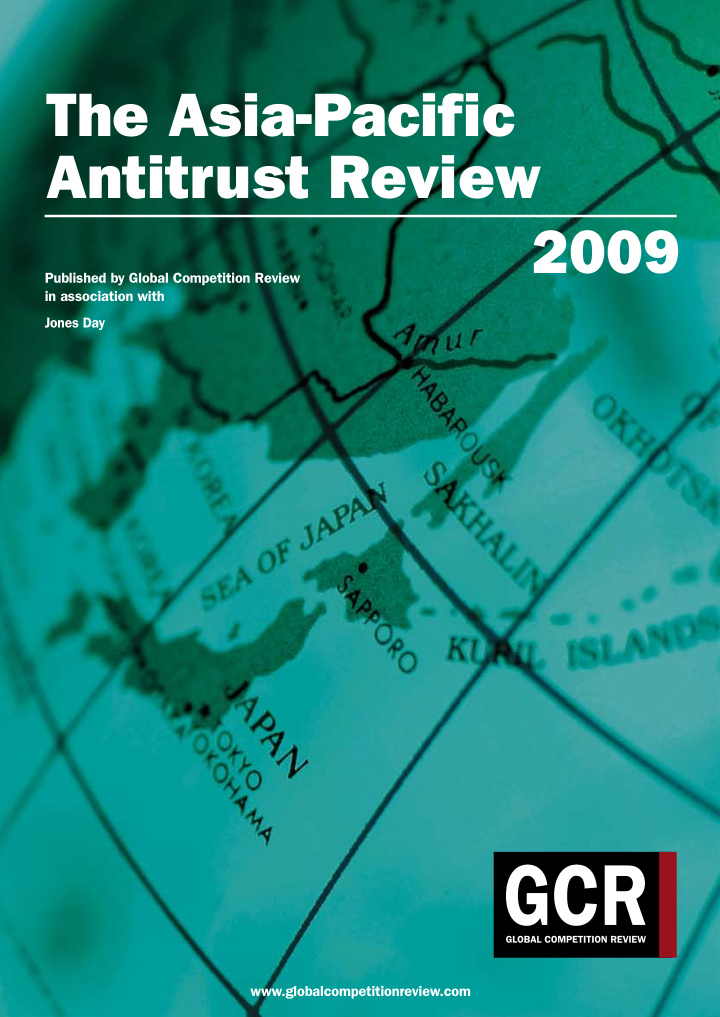



The Asia-Pacific Antitrust Review 2009 Published by Global Competition Review in association with Jones Day www.globalcompetitionreview.com
CHINA: MERGER CONTROL Merger Control in China Peter J Wang and Yizhe Zhang Jones Day The new comprehensive Antimonopoly Law of China (AML) took been formally accepted and 24 of which had been decided. In com- effect on 1 August 2008. Chapter 4 of the AML, ‘Concentration of parison, from 2003 to the end of July 2008, MOFCOM accepted and Undertakings’, sets forth the new Chinese merger control scheme reviewed more than 600 fjlings for mergers and acquisitions by foreign and supersedes earlier basic merger review provisions fjrst intro- investors under the old Foreign M&A Regulations. This appears to duced in March 2003 as part of the Regulation on Mergers and indicate that the heightened reporting thresholds have reduced the Acquisitions of Domestic Enterprises by Foreign Investors (Foreign rate of fjlings. MOFCOM is required to publish only rejections or M&A Regulations). conditional approvals. Of the 24 decisions made by MOFCOM under The merger control provisions (articles 20 to 31) of the AML the AML as of 18 March, only two – the conditional approval of the are largely consistent with international competition principles and Inbev/Anheuser-Busch transaction and the prohibition of the Coca- practices, although many aspects, including specifjc merger review Cola acquisition of Huiyuan – were formal denials or conditional thresholds and procedures, remain to be fjlled in by detailed regula- approvals. However, the data also indicate that a substantial number tions and actual enforcement practice. The AML chapter on merger of fjlings had not yet been accepted by MOFCOM, refmecting the gen- control also includes a controversial provision referencing national eral understanding that some notifjed transactions might have been security review of some foreign-related concentrations. stalled before or during the review process without formal rejection, The year 2009 will continue to be a time of great transition for as also appeared to be the case under the prior merger control regime the Chinese merger control regime, especially as it becomes increas- under the Foreign M&A Regulations. ingly important to multinational companies investing in China and a key part of global merger clearance for major transactions. Substantive standard The substantive test in Chinese merger review is framed by article 28 of the new AML, ie, whether the proposed concentration ‘will Latest developments The AML provides for the establishment of a two-tier anti- result in or may result in the effect of eliminating or restricting mar- monopoly system comprising the policymaking Antimonopoly Com- ket competition’. However, ‘AMEA may decide not to prohibit the mission (AMC) and the working level Antimonopoly Law Enforce- concentration if the undertakings involved can prove either that the ment Authority (AMEA). However, the AML itself does not specify positive effect of the concentration on competition obviously out- whether the AMC and the AMEA will be separate bodies or formed weighs the negative effect, or that the concentration is in the public out of existing agencies. Instead, the establishment and functions of interest’. Article 27 of the AML lists some factors to be considered each enforcement agency were clarifjed in an internal organisational during substantive review: policy paper promulgated by the State Council, the highest-ranking • the market share of the undertakings involved in the relevant executive body of the Chinese government. This is discussed in detail market and their ability to control market; in the ‘Regulatory authorities’ section below. • the degree of market concentration in the relevant market; The AML requires notifjcation of concentrations that reach noti- • the effect of the concentration on market entry and technological fjcation thresholds. Those thresholds were spelled out in the State progress; Council’s Regulation on Notifjcation Thresholds for Concentra- • the effect of the concentration on consumers and other under- tions of Undertakings (the Regulation on Notifjcation Thresholds), takings; effective 3 August 2008. In addition, MOFCOM has been actively • the effect of the concentration on national economic develop- formulating implementing rules under the AML and in early 2009 ment; and published for public comments at least fjve sets of draft provisional • other factors affecting market competition as determined by the rules and one set of draft Guidelines relating to various aspects of AMEA. the merger review process: • Draft Provisional Rules on the Investigation and Handling of Compared with the ‘substantial lessening of competition’ test in the Concentrations not notifjed in accordance with the Law; US and other jurisdictions, the standard of review under article 28 • Draft Provisional Rules on Collection of Evidence for Suspected lacks a requirement of ‘substantial’ or ‘material’ effect on competi- Monopolistic Concentrations below the Thresholds; tion. However, article 28 allows MOFCOM to balance any positive • Draft Provisional Rules on the Investigation and Handling of effects of the concentration on competition (ie, effjciencies) against Suspected Monopolistic Concentrations below the Thresholds; any potential negative effects. MOFCOM may also decide not to • Provisional Rules on the Notifjcation of Concentrations (Draft prohibit the transaction for public interest reasons, which remain Notifjcation Rule); undefjned. • Provisional Rules on the Review of Concentrations (Draft Article 27 appears to permit consideration of other goals, such Review Rule); and as protection of domestic competitors or national economic develop- • Draft Guidelines on the Defjnition of Relevant Markets. ment, that would be better separated from antitrust review. Indeed, MOFCOM expressly cited potential effects on small- and medium- According to MOFCOM, between 1 August 2008 and 18 March 2009 sized competing juice companies as one ground for its rejection of MOFCOM received over 40 fjlings under the AML, 29 of which had the Coca-Cola/Huiyuan transaction. In addition, the consideration 38 The Asia-Pacific Antitrust Review 2009
Recommend
More recommend